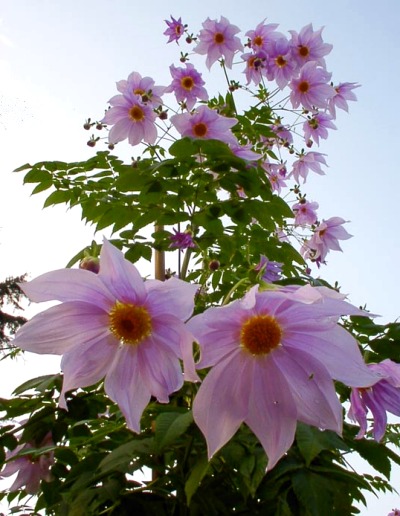Tree Dahlia
Rooting the cuttings
Please plant your cuttings as soon as you receive them. Start with a well-draining soil mix, such as 1 part potting soil to 1 part perlite, pumice or coarse horticultural sand. An alternate mix is 1 parts coir fiber to 2 parts perlite, with some slow-release fertilizer mixed in. Use a container about 1/2 to 1 gallon (2-4 liters) in size, with drainage holes. Plant the branch vertically about half-way in the soil, making sure at least one of the nodes is under the soil. I have marked the cuttings so that you know which end goes "up". Do not plant them upside down! If you have a rooting hormone like Rootone, or a fungicide, dust the branch with it first, although this is not necessary. After planting them, don't pack the soil down, and do not fertilize if your soil already contains fertilizer (check the label). Water the soil so that it's lightly moist throughout, but not soggy. Put the pots in a spot that is bright but without direct sun, and about 65-75 degrees F (18-24°C) day and night. Try to keep the soil evenly moist (but not soaked) until the cuttings have rooted. The cuttings should begin sending out roots within 1 to 2 months. Important: Cuttings often send out new growth before they have actually rooted, so do not give any direct sun until it has at least 8 inches (20 cm) of new growth and the branch is solidly rooted when you tug on it. Once it is well-rooted, start giving it either filtered sun, or 2-3 hours of morning or late afternoon sun. Increase the sun a little at a time until it is in 1/2 to full sun by the time it is 3 feet (1 meter) tall. Fertilizer -- About every 2 months, feed with a general-purpose fertilizer, following the directions on the package. It's normal for an older leaf to occasionally turn yellow and drop, but if it seems excessive, the soil may be too dry down in the root zone, or the plant may need more nitrogen fertilizer. Planting out -- Once the plant is 3 feet (1 meter) tall, it may be planted in the ground in suitable climates. If you keep it in a pot, use a large pot the first year, and an even bigger pot the following years, as the tubers grow bigger. In hotter climates, use an oversized pot of a light color, and shade the pot to keep the roots cool. Climate -- Tree Dahlia will flower in Zones 8 to 10, although it's known to flower in Zone 7b in warmer years. Temperatures below freezing may kill the flower stems, which appear around November or December. The dormant tubers are said to be hardy to 20-25 degrees F (-7 to -4°C) if planted deep and well-mulched. Or just move the tubers indoors for the winter. Protection from strong winds is recommended, as the new shoots and flower sprays are fairly delicate. Either full sun or a half-day of sun is fine. Watering -- Mature plants grown in the ground can be fairly drought-tolerant, but for the first couple of years, aim to keep the soil evenly moist most of the time. Pruning -- If for some reason you don't want a giant-sized plant, you may keep it to a reasonable height by pruning the tops one or more times throughout the season. Cutting the tips will make the plant bushier. After flowering, the plants naturally drop most or all of their branches. Dormancy -- Around January, after the plants have flowered, they usually drop some or all of their branches. You may cut the branches to the ground after flowering if you wish, or leave them. The tubers are said to be hardy to 20-25 degrees F (-7 to -4°C) if well-mulched. In colder areas, dig the tubers up and move them indoors until about April or May. Bugs to watch for -- Spider mites, aphids, leaf-miners, snails/slugs. By the way, if the cuttings are taking a long time to root, scratch the stem with your fingernail to see if it's green inside, which means it's still alive. Have fun growing them! - Jeff Strange Wonderful Things
|
|||||||||


